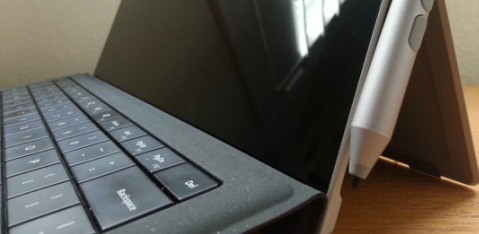
I spent a lot of time working with different tablet platforms and researched the Surface Pro 3 extensively doing comparisons with other computers in its class before I bought it. If you want to know more about my history with the tablet platform dating back to the Tablet PC, read my post, "How I go to the Surface (Pro 3)".
When the Pro 3 was announced. I read about the specs and waded through many reviews. I even found a great write up by a digital artist explaining the N-Trig technology vs the Wacom technology. The N-Trig provides me with enough sensitivity for my concept sketches using Autodesk Sketchbook Pro.
In comparison to the previous generation(s) of Surface Pro, the processor on the Pro 3 was dramatically more efficient leading to a better battery life, it had more RAM and it was lighter. It also had a larger screen with a different aspect ratio. At first, I was concerned the larger 12 inch screen might make it less portable. I saw pictures of the Surface Pro 3. It looked huge.
When I finally got to test one, it really seemed to solve almost all my issues with the original Surface Pro: kickstand, weight, and screen real estate. And it didn't seem as big as I thought it would.
I bought a Surface Pro 3 when it was first released. The bigger screen was definitely needed. It is big enough to feel comfortable using for extended periods but did not really affect the portability. In fact, surprisingly, with the weight loss, the larger size made it feel disproportionately lighter than the original Pro.
It's been about a year and I've used the Pro 3 for everything from email and web browsing to concept sketches and 3D modeling. It has gone with me around the US and abroad and I have been able to do all the work that I needed to on the go with one machine. Even without the docking station, it has replaced my desktop as my primary computer.
Bottom line, when I compared the combined package (processor, battery life, cost, size and active digitizer) to any ultra portable, laptop or convertible with similar specs, the Surface Pro 3 won out. It was the only system that had everything I needed.
It was not always the best in every category, but overall, the most versatile with enough for me to get the job done. I use my Pro 3 mostly for modeling. I have done light video editing and short (up to 2 minute) 3D animations. If you have different specific needs for the graphics card or processor then the Pro 3 may not be right for you.
Many reviews claimed it was overpriced, with an inferior battery life and too big and heavy. These reviews usually compared it to an iPad or Android tablet. Not a real comparison as they are not full computers. It's like comparing a Prius to an F-150, they serve entirely different purposes.
To decide what's right for you. Look at what you need to do. If you only need to read emails and browse the web then the Surface Pro 3 is overkill. There are many fine tablets and the iPad is one of the best among them. If you need an ultra portable, ultra versatile full computer, than the Surface Pro 3 is a good bet.
With the Surface 3 just released, and Surface Pro 4 on the horizon, I would love to hear the thoughts or experiences of other Surface Platform users especially with 3D and art related applications. Please leave a comment below.

 RSS Feed
RSS Feed